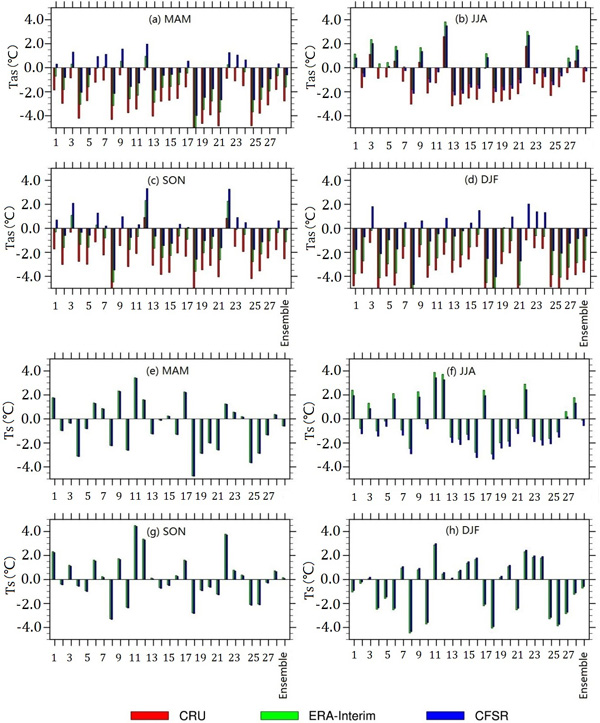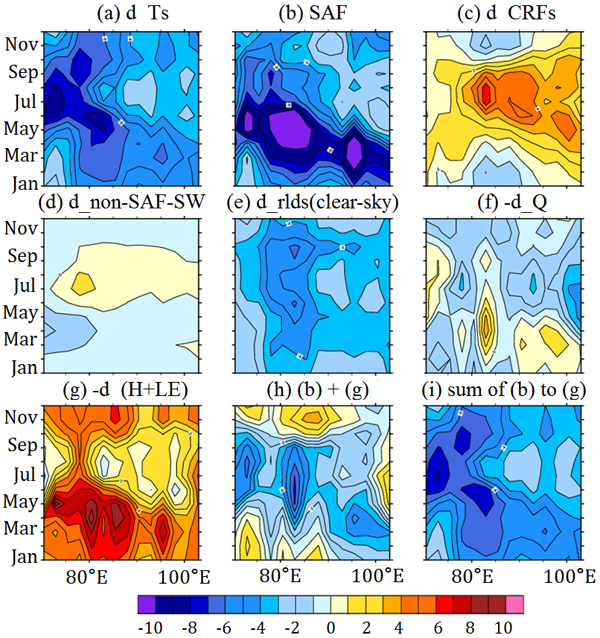State Key Laboratory of Numerical Modeling for Atmospheric Sciences and
Geophysical Fluid Dynamics (LASG)
Institute of Atmospheric Physics, Chinese Academy of Sciences

Vol. 4/No.4 December 2017
[Model development, algorithm, and evaluation] Understanding the Surface Temperature Cold Bias over the Tibetan Plateauin CMIP5 AGCMs
Studies on skin temperature (Ts) and 2-m air temperature (Tas) over the Tibetan Plateau (TP) have long been largely dependent on satellite data, reanalysis data and model simulations, due to the unique geographical environment of the TP, limited observation data and unevenly distributed meteorological stations. However, The majority of CMIP5 models underestimate annual and seasonal mean surface 2-m air temperatures (Tas) over the TP. The ensemble of the 28 AGCMs and half of the individual models underestimate annual mean skin temperatures (Ts) over the TP. The cold biases are larger in Tas than in Ts, and are larger over the western TP. To document the underlying processes of the Ts cold bias will be help for model improvement.
Recently, Dr. Chen Xiaolei, Prof. LIU Yimin and Prof. WU Guoxiong revealed the physics of the surface temperature cold bias over the TP in CMIP5 AGCMs. By decomposing the Ts bias using the surface energy budget equation, they investigated the contributions to the cold surface temperature bias on the TP from various factors, including the surface albedo-induced bias, surface cloud radiative forcing, clear-sky shortwave radiation, clear-sky downward longwave radiation, surface sensible heat flux, latent heat flux, and heat storage. The results show a suite of physically interlinked processes contributing to the cold surface temperature bias. Strong negative surface albedo-induced bias associated with excessive snow cover and the surface heat fluxes are highly anti-correlated, and the cancelling out of these two terms leads to a relatively weak contribution to the cold bias. Smaller surface turbulent fluxes lead to colder lower-tropospheric temperature and lower water vapor content, which in turn cause stronger negative downward clear-sky longwave radiation and cold bias. The results suggest that snow cover parameterization and improvements in boundary layer parameterization, and hence surface turbulent fluxes, may help to reduce the cold bias over the TP in the models.

Fig. 1. Seasonal mean temperature differences between CMIP5 models and observations [CRU and two reanalysis products (ERA-Interim and CFSR)] averaged over the 60 grid boxes from 1979–2005: (a–d) Tas differences between the models, CRU data and reanalysis products; (e–h) Ts differences between the models and reanalysis products. All temperature data in the models and reanalysis products have been corrected based on actual elevation at a resolution of 2.5° × 2.5°. The numbers at the bottom of the plots indicate the different models.

Fig. 2. Differences (K) in the various terms between the cold surface bias over the TP (cTP) models and the warm surface bias over the TP (wTP) models. The vertical coordinates represent months. the horizontal axis is the meridional mean averaged over the grid boxes with the same longitude: (a) Ts difference, along with that due to (b) surface albedo feedback, (c) surface CRF, (d) non-SAF associated with clear-sky SW radiation, (e) non-SAF associated with net clear-sky LW radiation fluxes, (f) heat storage, (g) surface sensible and latent fluxes, and (h) the sum of (b) and (g), while (i) is the sum of (b) through (g).

Fig. 3. Differences between the cTP and wTP models in (a) meridionally averaged snow area fraction, (b) annual mean atmospheric temperature in the vertical direction, and (c) column water vapor content (kg m-2). The meridional mean over the TP is used in (a) and (b).
This study is published in Advances in Atmospheric Sciences 34, (doi: 10.1007s00376-017-6326-9.).
Citation:
Chen, X. L., Y. M. Liu, and G. X. Wu, 2017: Understanding the surface temperature cold bias in CMIP5 AGCMs over the Tibetan Plateau. Adv. Atmos. Sci., 34, doi: 10.1007s00376-017-6326-9.
Download: http://159.226.119.58/aas/EN/10.1007s00376-017-6326-9.
Contact: LIU Yimin, lym@lasg.iap.ac.cn
E-mail: lasg_newsletter@lasg.iap.ac.cn
Editors: Chuanyi Wang (wangcy@lasg.iap.ac.cn), Kangjun Chen(ckj@lasg.iap.ac.cn)